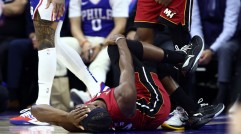Michael Brown Shooting Update: Ferguson Police Stopped Far More Blacks Than Whites in 2013
In Ferguson, Missouri, two-thirds of the population is black, but the city's police force is predominantly white. The imbalance between Ferguson's population and its police department has people wary of potential racial profiling.
The Missouri Attorney General's Office published the city's racial profiling data from 2013, and blacks are more likely to be stopped, searched and arrested than whites, Asians or Hispanics.
The racial profiling data from the state's attorney general are based on vehicle stops. With a population of 15,865 of people over the age of 16, 4,632 blacks were stopped by the Ferguson police department, compared to 686 whites. For Hispanics, 22 people were stopped by the police, followed by 12 Asians, eight American Indians and 24 "other." In total, Ferguson police stopped 5,384 people during 2013.
Last year, Ferguson police conducted 611 searches, 562 of which were of black. Whites ranked second with 47 searches, and one Hispanic and American Indian were searched. While 521 arrests were made during vehicle stops in 2013, only one person was Hispanic and one American Indian. Meanwhile, 483 of those arrested were black, and 36 were white.
Although more blacks were stopped, searched and arrested, whites were more likely to have contraband than blacks and Hispanics. According to the Missouri attorney general, no Hispanics were involved with contraband.
Reasons for the vehicle stops were because the car was "moving," equipment, license or for an investigation. Most of the vehicle stops on blacks and Hispanics were done on city streets.
Black women were stopped more times than black men -- 2,435 versus 2,197. More Hispanic men were stopped than Hispanic women, 16 and six, respectively.
The spotlight on Ferguson comes after 18-year-old Michael Brown was shot by a police officer on Aug. 9. Brown was shot multiple times, and his body was left outside for hours as Ferguson and the St. Louis County Police Department investigated the scene. The St. Louis Police Department has since taken over responsibility of the investigation.
Brown's death resulted in protests by residents against the police department's treatment of the community. Protesters have used social media to document events and behaviors of the police. The protests have led police to launch tear gas at protesters and arrest dozens of people, including journalists, notably from The Washington Post and Huffington Post.
"The right to record and report on police activities is a First Amendment right -- and one essential to the journalist's role as a watchdog and guardian of public accountability for law enforcement and other public officials," the Reporters Committee for the Freedom of the Press said in a statement. "That it should be so disregarded, particularly after the journalists identified themselves as members of the press, is almost unthinkable -- yet it happened and happened quite violently according to news reports."
In a press conference on Thursday, President Barack Obama announced the Department of Justice and FBI will independently investigate Brown's death. The DOJ is also tasked with consulting with local authorities on methods to maintain public safety without infringing on the right to a peaceful protest.
"There is never an excuse for violence against police, or for those who would use this tragedy as a cover for vandalism or looting. There's also no excuse for police to use excessive force against peaceful protests, or to throw protesters in jail for lawfully exercising their First Amendment rights," Obama said.
__
For the latest updates, follow Latin Post's Michael Oleaga on Twitter: @EditorMikeO or contact via email: m.oleaga@latinpost.com.
Subscribe to Latin Post!
Sign up for our free newsletter for the Latest coverage!














